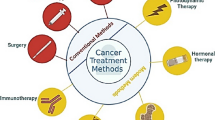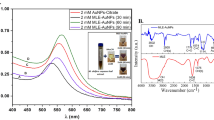Abstract
Environmentally benign-synthesized gold nanoparticles (Au-NPs) have received substantial attention owing to their biomedical applications, particularly in cancer therapy. In the current study, Backhousia citriodora (B. citriodora) leaf extract was applied as a reducing agent for one-pot synthesis of controlled size Au-NPs. The effect of various parameters such as reaction time, pH, and B. citriodora leaf boiling time on the synthesis of Au-NPs was studied. The characterization of the Au-NPs synthesized at 15.0-min incubation time showed colour change because of the surface plasma resonance band around 530.0 nm. TEM photographs showed spherical morphologies with an average size of 8.40 ± 0.084 nm and zeta potential value was − 29.74 mV, indicating stability of the nanoparticles. The biomedical properties of Au-NPs and B. citriodora leaf extract showed strong DPPH radical scavenging. The in vitro anticancer activity determined using MTT assay exhibited that Au-NPs showed a significant dose-dependent reduction in the viability of the MCF-7 breast cancer cell line and the HepG2 liver cancer cell line with IC50 values of 116.65 and 108.21 µg, respectively.





Similar content being viewed by others
References
Soundarrajan C, Sankari A, Dhandapani P, Maruthamuthu S, Ravichandran S, Sozhan G, Palaniswamy N (2012) Rapid biological synthesis of platinum nanoparticles using Ocimum sanctum for water electrolysis applications. Bioprocess Biosyst Eng 35(5):827–833
Hoshyar R, Khayati GR, Poorgholami M, Kaykhaii M (2016) A novel green one-step synthesis of gold nanoparticles using crocin and their anti-cancer activities. J Photochem Photobiol B 159:237–242
Shankar SS, Rai A, Ahmad A, Sastry M (2004) Rapid synthesis of Au, Ag, and bimetallic Au core–Ag shell nanoparticles using Neem (Azadirachta indica) leaf broth. J Colloid Interface Sci 275(2):496–502
Daniel M-C, Astruc D (2004) Gold nanoparticles: assembly, supramolecular chemistry, quantum-size-related properties, and applications toward biology, catalysis, and nanotechnology. Chem Rev 104(1):293–346
Dash SS, Bag BG (2014) Synthesis of gold nanoparticles using renewable Punica granatum juice and study of its catalytic activity. Appl Nanosci 4(1):55–59
Murphy CJ, Gole AM, Stone JW, Sisco PN, Alkilany AM, Goldsmith EC, Baxter SC (2008) Gold nanoparticles in biology: beyond toxicity to cellular imaging. Acc Chem Res 41(12):1721–1730
Rajeshkumar S (2016) Anticancer activity of eco-friendly gold nanoparticles against lung and liver cancer cells. J Genet Eng Biotechnol 14:195–202
Khan Z, Bashir O, Hussain JI, Kumar S, Ahmad R (2012) Effects of ionic surfactants on the morphology of silver nanoparticles using Paan (Piper betel) leaf petiole extract. Colloids Surf B 98:85–90
Khademi-Azandehi P, Moghaddam J (2015) Green synthesis, characterization and physiological stability of gold nanoparticles from Stachys lavandulifolia Vahl extract. Particuology 19:22–26
Kharissova OV, Dias HR, Kharisov BI, Pérez BO, Pérez VMJ (2013) The greener synthesis of nanoparticles. Trends Biotechnol 31(4):240–248
Santra TS, Tseng F-G, Barik TK (2014) Green biosynthesis of gold nanoparticles and biomedical applications. Am J Nano Res Appl 2(6–2):5–12
Irfan M, Ahmad T, Moniruzzaman MM, Abdullah BB, Bhattacharjee S (2016) Ionic liquid mediated biosynthesis of gold nanoparticles using Elaeis guineensis (oil palm) leaves extract. Procedia Eng 148:568–572
Gan PP, Li SFY (2012) Potential of plant as a biological factory to synthesize gold and silver nanoparticles and their applications. Rev Environ Sci Biotechnol 11(2):169–206
Dorosti N, Jamshidi F (2016) Plant-mediated gold nanoparticles by Dracocephalum kotschyi as anticholinesterase agent: synthesis, characterization, and evaluation of anticancer and antibacterial activity. J Appl Biomed 14:235–245
Guo Y, Sakulnarmrat K, Konczak I (2014) Anti-inflammatory potential of native Australian herbs polyphenols. Toxicol Rep 1:385–390
Devi JS, Bhimba BV (2012) Silver nanoparticles: antibacterial activity against wound isolates & invitro cytotoxic activity on Human Caucasian colon adenocarcinoma. Asian Pac J Trop Dis 2:S87–S93
Unno Y, Shino Y, Kondo F, Igarashi N, Wang G, Shimura R, Yamaguchi T, Asano T, Saisho H, Sekiya S (2005) Oncolytic viral therapy for cervical and ovarian cancer cells by Sindbis virus AR339 strain. Clin Cancer Res 11(12):4553–4560
Rosarin FS, Arulmozhi V, Nagarajan S, Mirunalini S (2013) Antiproliferative effect of silver nanoparticles synthesized using amla on Hep2 cell line. Asian Pac J Trop Med 6(1):1–10
Mukherjee S, Ghosh S, Das DK, Chakraborty P, Choudhury S, Gupta P, Adhikary A, Dey S, Chattopadhyay S (2015) Gold-conjugated green tea nanoparticles for enhanced anti-tumor activities and hepatoprotection—synthesis, characterization and in vitro evaluation. J Nutr Biochem 26(11):1283–1297
Sathishkumar M, Pavagadhi S, Mahadevan A, Balasubramanian R (2015) Biosynthesis of gold nanoparticles and related cytotoxicity evaluation using A549 cells. Ecotoxicol Environ Saf 114:232–240
Murphy P, LaGrange M (1998) Raman spectroscopy of gold chloro-hydroxy speciation in fluids at ambient temperature and pressure: a re-evaluation of the effects of pH and chloride concentration. Geochim Cosmochim Acta 62(21):3515–3526
Sathishkumar M, Mahadevan A, Vijayaraghavan K, Pavagadhi S, Balasubramanian R (2010) Green recovery of gold through biosorption, biocrystallization, and pyro-crystallization. Ind Eng Chem Res 49(16):7129–7135
Naczk M, Shahidi F (2007) Corrigendum to “Phenolics in cereals, fruits and vegetables: occurrence, extraction and analysis”. J Pharm Biomed Anal 43(2):798 [(2006) J Pharm Biomed Anal 41:1523–1542]
Sneha K, Sathishkumar M, Kim S, Yun Y-S (2010) Counter ions and temperature incorporated tailoring of biogenic gold nanoparticles. Process Biochem 45(9):1450–1458
Xin Lee K, Shameli K, Miyake M, Kuwano N, Bt Ahmad Khairudin NB, Bt Mohamad SE, Yew YP (2016) Green synthesis of gold nanoparticles using aqueous extract of Garcinia mangostana fruit peels. J Nanomater 2016:7
Shahzadi P, Muhammad A, Mehmood F, Chaudhry MY (2014) Synthesis of 3, 7-dimethyl-2, 6-octadienal acetals from citral extracted from lemon grass, Cymbopogon citrates L. J Antivir Antiretrovir 2014:028–031
Baker S, Satish S (2015) Biosynthesis of gold nanoparticles by Pseudomonas veronii AS41G inhabiting Annona squamosa L, Spectrochim. Acta A 150:691–695
Mishra P, Ray S, Sinha S, Das B, Khan MI, Behera SK, Yun S-I, Tripathy SK, Mishra A (2016) Facile bio-synthesis of gold nanoparticles by using extract of Hibiscus sabdariffa and evaluation of its cytotoxicity against U87 glioblastoma cells under hyperglycemic condition. Biochem Eng J 105:264–272
Ajitha B, Reddy YAK, Reddy PS (2015) Green synthesis and characterization of silver nanoparticles using Lantana camara leaf extract. Mater Sci Eng C 49:373–381
Khandanlou R, Ngoh GC, Chong WT, Bayat S, Saki E (2016) Fabrication of silver nanoparticles supported on rice straw. In vitro antibacterial activity and its heterogeneous catalysis in the degradation of 4-nitrophenol. BioResources 11(2):3691–3708
Levard C, Hotze EM, Lowry GV, Brown GE Jr (2012) Environmental transformations of silver nanoparticles: impact on stability and toxicity. Environ Sci Technol 46(13):6900–6914
Karakoçak BB, Raliya R, Davis JT, Chavalmane S, Wang W-N, Ravi N, Biswas P (2016) Biocompatibility of gold nanoparticles in retinal pigment epithelial cell line. Toxicol In Vitro 37:61–69
Stolarczyk EU, Stolarczyk K, Łaszcz M, Kubiszewski M, Maruszak W, Olejarz W, Bryk D (2017) Synthesis and characterization of genistein conjugated with gold nanoparticles and the study of their cytotoxic properties. Eur J Pharm Sci 96:176–185
Konczak I, Zabaras D, Dunstan M, Aguas P (2010) Antioxidant capacity and phenolic compounds in commercially grown native Australian herbs and spices. Food Chem 122(1):260–266
Rupesinghe EJR, Jones A, Shalliker RA, Pravadali-Cekic S (2016) A rapid screening analysis of antioxidant compounds in native australian food plants using multiplexed detection with active flow technology columns. Molecules 21(1):118
Mata R, Nakkala JR, Sadras SR (2016) Polyphenol stabilized colloidal gold nanoparticles from Abutilon indicum leaf extract induce apoptosis in HT-29 colon cancer cells. Colloids Surf B 143:499–510
Nirmala JG, Akila S, Narendhirakannan R, Chatterjee S (2017) Vitis vinifera peel polyphenols stabilized gold nanoparticles induce cytotoxicity and apoptotic cell death in A431 skin cancer cell lines. Adv Powder Technol 28:1170–1184
Patra HK, Banerjee S, Chaudhuri U, Lahiri P, Dasgupta AK (2007) Cell selective response to gold nanoparticles. Nanomed Nanotech Biol Med 3(2):111–119
Connor EE, Mwamuka J, Gole A, Murphy CJ, Wyatt MD (2005) Gold nanoparticles are taken up by human cells but do not cause acute cytotoxicity. Small 1(3):325–327
Alkilany AM, Nagaria PK, Hexel CR, Shaw TJ, Murphy CJ, Wyatt MD (2009) Cellular uptake and cytotoxicity of gold nanorods: molecular origin of cytotoxicity and surface effects. Small 5(6):701–708
Chithrani BD, Ghazani AA, Chan WC (2006) Determining the size and shape dependence of gold nanoparticle uptake into mammalian cells. Nano Lett 6(4):662–668
AshaRani P, Low Kah Mun G, Hande MP, Valiyaveettil S (2008) Cytotoxicity and genotoxicity of silver nanoparticles in human cells. ACS Nano 3(2):279–290
Kroemer G (1995) The pharmacology of T cell apoptosis. Adv Immunol 58:211–296
Kumar R, Dwivedi PD, Dhawan A, Das M, Ansari KM (2011) Citrinin-generated reactive oxygen species cause cell cycle arrest leading to apoptosis via the intrinsic mitochondrial pathway in mouse skin. Toxicol Sci 122(2):557–566
Nagajyothi P, Muthuraman P, Sreekanth T, Kim DH, Shim J (2016) Green synthesis: in-vitro anticancer activity of copper oxide nanoparticles against human cervical carcinoma cells. Arab J Chem 10:215–225
Alkilany AM, Murphy CJ (2010) Toxicity and cellular uptake of gold nanoparticles: What we have learned so far? J Nanopart Res 12(7):2313–2333
Arvizo R, Bhattacharya R, Mukherjee P (2010) Gold nanoparticles: opportunities and challenges in nanomedicine. Expert Opin Drug Deliv 7(6):753–763
Sonavane G, Tomoda K, Makino K (2008) Biodistribution of colloidal gold nanoparticles after intravenous administration: effect of particle size. Colloid Surf B 66(2):274–280
Chen Y-S, Hung Y-C, Liau I, Huang GS (2009) Assessment of the in vivo toxicity of gold nanoparticles. Nanoscale Res Lett 4(8):858
Cho W-S, Cho M, Jeong J, Choi M, Cho H-Y, Han BS, Kim SH, Kim HO, Lim YT, Chung BH (2009) Acute toxicity and pharmacokinetics of 13 nm-sized PEG-coated gold nanoparticles. Toxicol Appl Pharmacol 236(1):16–24
Dobrovolskaia MA, Patri AK, Zheng J, Clogston JD, Ayub N, Aggarwal P, Neun BW, Hall JB, McNeil SE (2009) Interaction of colloidal gold nanoparticles with human blood: effects on particle size and analysis of plasma protein binding profiles. Nanomed Nanotech Biol Med 5(2):106–117
Acknowledgements
The authors would like to thank the Charles Darwin University for its financial support (faculty research Grant), the Central Analytical Research Facility (CARF) operated by the Institute for Future Environments, Queensland University of Technology (QUT) for SEM, TEM, and XRD facilities and Dr. Sivanesan Arumugam at the Future Industries Institute (FII), University of South Australia, for assistance with obtaining zeta potential values in this research.
Author information
Authors and Affiliations
Corresponding author
Ethics declarations
Conflict of interest
The authors declare that they have no conflict of interest.
Rights and permissions
About this article
Cite this article
Khandanlou, R., Murthy, V., Saranath, D. et al. Synthesis and characterization of gold-conjugated Backhousia citriodora nanoparticles and their anticancer activity against MCF-7 breast and HepG2 liver cancer cell lines. J Mater Sci 53, 3106–3118 (2018). https://doi.org/10.1007/s10853-017-1756-4
Received:
Accepted:
Published:
Issue Date:
DOI: https://doi.org/10.1007/s10853-017-1756-4




